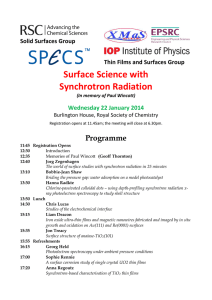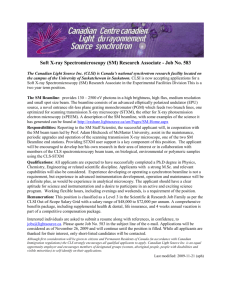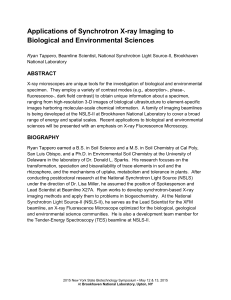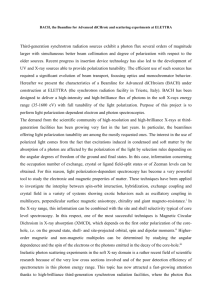Photoelectron spectroscopy beamline on Indus-1 synchrotron radiation source S. M. Chaudhari*
advertisement
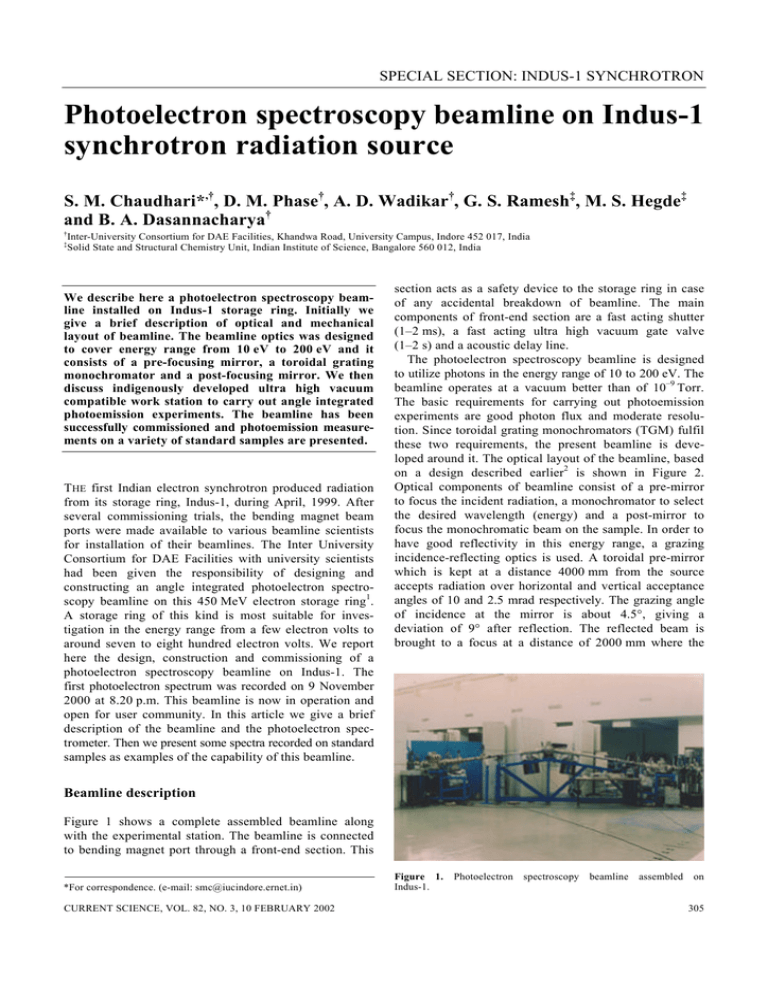
SPECIAL SECTION: INDUS-1 SYNCHROTRON Photoelectron spectroscopy beamline on Indus-1 synchrotron radiation source S. M. Chaudhari*,†, D. M. Phase†, A. D. Wadikar†, G. S. Ramesh‡, M. S. Hegde‡ and B. A. Dasannacharya† † ‡ Inter-University Consortium for DAE Facilities, Khandwa Road, University Campus, Indore 452 017, India Solid State and Structural Chemistry Unit, Indian Institute of Science, Bangalore 560 012, India We describe here a photoelectron spectroscopy beamline installed on Indus-1 storage ring. Initially we give a brief description of optical and mechanical layout of beamline. The beamline optics was designed to cover energy range from 10 eV to 200 eV and it consists of a pre-focusing mirror, a toroidal grating monochromator and a post-focusing mirror. We then discuss indigenously developed ultra high vacuum compatible work station to carry out angle integrated photoemission experiments. The beamline has been successfully commissioned and photoemission measurements on a variety of standard samples are presented. THE first Indian electron synchrotron produced radiation from its storage ring, Indus-1, during April, 1999. After several commissioning trials, the bending magnet beam ports were made available to various beamline scientists for installation of their beamlines. The Inter University Consortium for DAE Facilities with university scientists had been given the responsibility of designing and constructing an angle integrated photoelectron spectroscopy beamline on this 450 MeV electron storage ring1. A storage ring of this kind is most suitable for investigation in the energy range from a few electron volts to around seven to eight hundred electron volts. We report here the design, construction and commissioning of a photoelectron spectroscopy beamline on Indus-1. The first photoelectron spectrum was recorded on 9 November 2000 at 8.20 p.m. This beamline is now in operation and open for user community. In this article we give a brief description of the beamline and the photoelectron spectrometer. Then we present some spectra recorded on standard samples as examples of the capability of this beamline. section acts as a safety device to the storage ring in case of any accidental breakdown of beamline. The main components of front-end section are a fast acting shutter (1–2 ms), a fast acting ultra high vacuum gate valve (1–2 s) and a acoustic delay line. The photoelectron spectroscopy beamline is designed to utilize photons in the energy range of 10 to 200 eV. The beamline operates at a vacuum better than of 10–9 Torr. The basic requirements for carrying out photoemission experiments are good photon flux and moderate resolution. Since toroidal grating monochromators (TGM) fulfil these two requirements, the present beamline is developed around it. The optical layout of the beamline, based on a design described earlier2 is shown in Figure 2. Optical components of beamline consist of a pre-mirror to focus the incident radiation, a monochromator to select the desired wavelength (energy) and a post-mirror to focus the monochromatic beam on the sample. In order to have good reflectivity in this energy range, a grazing incidence-reflecting optics is used. A toroidal pre-mirror which is kept at a distance 4000 mm from the source accepts radiation over horizontal and vertical acceptance angles of 10 and 2.5 mrad respectively. The grazing angle of incidence at the mirror is about 4.5°, giving a deviation of 9° after reflection. The reflected beam is brought to a focus at a distance of 2000 mm where the Beamline description Figure 1 shows a complete assembled beamline along with the experimental station. The beamline is connected to bending magnet port through a front-end section. This *For correspondence. (e-mail: smc@iucindore.ernet.in) CURRENT SCIENCE, VOL. 82, NO. 3, 10 FEBRUARY 2002 Figure 1. Indus-1. Photoelectron spectroscopy beamline assembled on 305 SPECIAL SECTION: INDUS-1 SYNCHROTRON Figure 2. Table 1. Optical layout of photoelectron spectroscopy beamline. Beamline specifications Source Bending magnet of INUDS-1 Acceptance 10 mrad (H) × 2.5 mrad (V) Mirror 1 Pt-coated toroidal mirror to focus the SR beam on the entrance slit, demagnification 2 : 1 Entrance and exit slit Adjustable (horizontally) from 0.4 mm to 3 mm in four discrete steps and (vertically) continuously from 0 to 1.8 mm Monochromator Toroidal grating monochromator (TGM-2600), total deflection 2θ = 162°; Three Pt-coated gratings interchangeable under ultra high vacuum Energy range Gratings (lines/mm) 200 600 1800 Energy range (eV) 10–23 23–69 69–200 Resolving power (E/δE) measured with discharge source 650 at He(I) line 950 at He(II) line – Mirror 2 Pt-coated toroidal mirror to refocus the monochromatic beam from exit slit to a sample located at 990 mm. magnification 1 : 1 Spot size Typically 1 mm (H) × 1 mm (V) Experimental station UHV compatible angle integrated photoelectron spectrometer comprising (a) Hemispherical analyser having mean radius of 95 mm. (b) Ion gun and diamond scrapper for thin and bulk sample cleaning respectively. (c) Sample heating (up to 900°C) and cooling (down to LN2 temperature). (d) Sample manipulator with XYZ motion. (e) Sample preparation chamber with quick load lock and sample transfer system. Experiments Photoemission (angle integrated) studies. entrance slit of TGM is located. The pre-mirror section is followed by a TGM (Jobin Yvon-TGM2634) which contains three interchangeable gratings to cover a photon energy range from 10 to 200 eV. Any one of the three gratings can be brought into working position to select 306 the desired energy. Energy scanning is achieved by rotating the grating around its axis passing through its centre. Monochromatized beam passing an exit slit falls on postfocusing toroidal mirror. This mirror has entrance and exit arm distance of 990 mm. The deviation produced by this mirror is 9° keeping outgoing radiation parallel to incoming beam. This mirror produces a unit magnification. The mechanical layout of beamline includes various components such as laser alignment box to align the beamline, beam viewers after each optical element to monitor the beam and a photodiode after the post-mirror to measure the incident flux. The mechanical design has three modules, viz. pre-mirror chamber, monochromator and post-mirror chamber. Each module3 is separated by ultra high vacuum gate valve. This construction helps in avoiding venting the complete beamline in case of any breakdown. The mechanical design of pre-mirror and post-mirror chamber and its holding mechanism is made in such a way that very fine linear, rotary and tilt motions can be imparted to the mirrors under ultra high vacuum conditions for final alignment. A vacuum of the order of 1 × 10 –9 Torr in beamline is obtained by distributed ion and turbo pump combination. The experimental station of this beamline is an angle integrated photoelectron spectrometer, which was also designed and fabricated indigenously. It consists of (i) an energy analyzer, (ii) an experimental chamber with in situ heating and cooling arrangement of the sample mount on XYZ sample manipulator, (iii) preparation chamber equipped with magnetic sample transfer rod, ion gun and diamond file scrapper, and (iv) the associated electronics with data acquisition system. The energy analyser consists of an electrostatic lens, a hemispherical analyser and a detector. The lens is a three-piece cylindrical system. Each cylinder is machined out of stainless steel and mirror-polished and coated with gold for good transmission of beam. The inner and outer hemispheres CURRENT SCIENCE, VOL. 82, NO. 3, 10 FEBRUARY 2002 SPECIAL SECTION: INDUS-1 SYNCHROTRON a b Figure 3. Photoelectron spectra of (a) Pt core level and (b) Ag valence band. Quality of Ag spectrum is affected due to the presence of an oxide layer. Counts (AU) a b Binding Energy (eV) Figure 4. a, Core level and b, valence band spectra of Pt. of the analyser are machined out of aluminum to an accuracy better than ± 0.001 mm. The surfaces are then polished and coated with gold. The hemispheres are mounted on a fringe plate which is also machined out of aluminum. It has an entrance and an exit slit of which, width can be varied from 1 mm to 3 mm in steps of CURRENT SCIENCE, VOL. 82, NO. 3, 10 FEBRUARY 2002 1 mm. The entire analyser assembly is mounted such that the inner hemisphere, the outer hemisphere and the fringe plate are isolated from each other by using teflon washers and bushes. There are six concentric rings made out of stainless steel mounted on fringe plate to correct the fringe field and improve the resolution of the analyser. These rings are positioned equidistantly in the gap between the two hemispheres. The inner and outer hemispheres have a radii of 65 mm and 125 mm respectively. A channel electron multiplier (X719 BL, Philips make) is used as a detector which is mounted below the exit of the analyser. µ-metal shields surround the analyser, lens and experimental chamber for shielding them from earth’s magnetic field. The electronic system consists of a spectrometer control unit to provide various voltages to the energy analyser, a pulse amplifier to amplify the detected signal and a rate meter. The electronics system is interfaced to an IBM compatible personal computer and a Windows-based software, written in Viewbasic, is used to operate the spectrometer. Table 1 gives beamline specifications normally needed to plan experiments for users. Measurements After commissioning the beamline on Indus-1, the first photoelectron spectrum was recorded successfully on 9 November 2000 at 8.20 p.m. The spectrum was recorded 307 SPECIAL SECTION: INDUS-1 SYNCHROTRON with spectrometer slit width setting of 3 mm at 30 eV analyser pass energy. The as-recorded-spectra for Pt core level and Ag valence band are shown in Figure 3 a and b respectively. Improved spectra of Pt core level and Figure 5. Valence band spectrum of Cu along with theoretical density of states (dashed line). Figure 6. Valence band spectrum of GaAs having typical three peak structure (I, p-states, II; sp, hybridized states; III, s-states). Figure 7. Core level spectrum of GaAs. Both spectra are fitted with three components corresponding to 3d5/2, 3d3/2 and oxide states. 308 valence band were subsequently recorded with lower background counts (Figure 4 a and b). The Pt core level spectrum shows well resolved two spin-orbit split peaks corresponding to 4f5/2 and 4f7/2 levels at binding energy values 74.6 eV and 71.2 eV respectively. The spin-orbit splitting of 3.3 eV matches well with that reported in the literature. The measured FWHM, which is a measure of energy resolution, is 0.8 eV. Figure 4 b shows valence band spectrum of Pt foil and shows a two-peak structure corresponding to 5d5/2 and 5d3/2 at about 2 eV and 5 eV respectively. Valence band and core level spectra have been recorded for Cu, Au and W thin films. Figure 5 shows valence band photoelectron spectrum of 50 Å thick Cu film. Essentially all features corresponding to Cu–3d valence band are clearly reproduced. The measured spectrum is compared with theoretical density of states calculations reported by Burdick4. This study has therefore shown that valence band and core level spectra can be recorded with good intensity using the present beamline. Figure 6 shows valence band spectrum of p-GaAs (100) sample recorded at 134 eV photon energy keeping pass energy of 30 eV. (This is a part of an experimental program undertaken by S. K. Kulkarni, Pune Univ.) The recorded spectrum has a typical three-peak structure. Peak-I represents predominantly p-states, II-sp-hybridized states and III-mainly s-states. In addition, a peak due to O-2p valence band is also present. The energies of peaks I, II and III are 3.7 eV, 5.81 eV and 11.67 eV respectively are in agreement with the reported values5. The core level spectrum of Ga and As 3d levels is shown in Figure 7. The two peaks at 18.4 eV and 41.3 eV correspond to 3d core level of Ga and As respectively. Observed peaks are broad with FWHM 1.58 eV and 1.68 eV for Ga and As respectively. Each spectrum is fitted with three components. These components in the case of Ga correspond to 3d5/2 and 3d3/2 and its oxide with corresponding binding energy values of 18.52 eV, 18.96 eV Figure 8. Valence band spectrum of Sr2RuO4. CURRENT SCIENCE, VOL. 82, NO. 3, 10 FEBRUARY 2002 SPECIAL SECTION: INDUS-1 SYNCHROTRON and 19.52 eV. Similarly in the case of As three components corresponding to 3d5/2, 3d3/2 and its oxide at binding energy value of 40.48 eV, 41.15 eV and 41.69 eV are fitted. The peak positions are in agreement with the values observed in earlier studies6–8. Figure 8 shows valence band spectrum from an oxide sample, viz. Sr2RuO4, which has been studied earlier in our laboratory9. The spectrum, as expected can be recorded much faster than in an UPS or XPS laboratory experiment. Summary A photoelectron spectroscopy beamline designed for 10– 200 eV photon energy range and tested for over the energy range 70–200 eV has been installed on a bending magnet source of Indus-1. A number of photoelectron spectra have been recorded on bulk metal, film, semiconductor and oxide systems with variable incident photon energy from 70 to 200 eV. The reported spectra demonstrate that good quality data can be generated with the present beamline. The beamline is open for user community. CURRENT SCIENCE, VOL. 82, NO. 3, 10 FEBRUARY 2002 1. Ramamurthi, S. S. and Singh, G., Nucl. Instrum. Methods, 1995, A359, 15–20. 2. Chaudhari, S. M. and Pimpale, A. V., Nucl. Instrum. Methods, 1995, A359, 274–283. 3. Chaudhari, S. M., Phase, D. M., Kulkarni, G. R. and Pimpale, A. V., Proceedings of the International Conference on Vacuum Science and SRS Technology (INCOVAST) (eds Sinha, A. K. and Venkatramani, N.), Indore, India, 1995, vol. 1, pp. 283–293. 4. Burdick, G. A., Phys. Rev., 1963, 129, 138–150. 5. Key, L., Pollak, R. A., Mcfeely, F. R., Kawalezyk, S. P. and Shirley, D. A., Phys. Rev., 1974, B9, 600–621. 6. Shoji, D., Taka-aki Miura, M., Niwana and Miyamata, N., Appl. Surf. Sci., 1998, 130–132, 441–446. 7. Zahn, D. R. T., Kampen, T. U., Hohmecker, S. and Brown, W., Vacuum, 2000, 57, 139–144. 8. Spicer, W. E., Lindeu, I., Gregory, P. E., Garner, C. M., Piantta, P. and Chye, P. W., J. Vac. Sci. Technol., 1976, 13, 780– 785. 9. Rama Rao, M. V., Sathe, V. G., Sornaduari, D., Panigrahi, B. and Shripathi, T., J. Phys. Chem. Solids, 2000, 61, 1989–1999. ACKNOWLEDGEMENTS. Many university groups and scientists from various institutions helped in initial work of beamline. We thank Prof. V. G. Bhide, Prof. R. Srinivasan, Dr A. V. Pimpale and Dr S. K. Kulkarni for their active involvement during designing work of the beamline. 309
